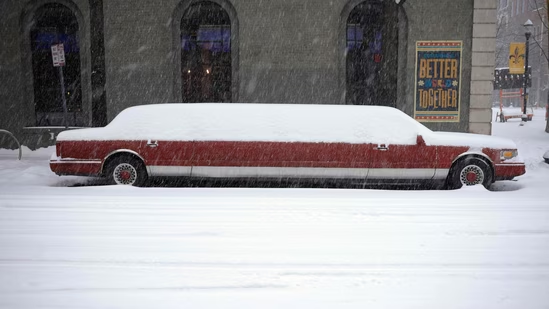A brutal winter storm, dubbed Winter Storm Blair, has brought the United States to a standstill, causing widespread disruptions and prompting six states to declare a state of emergency. With over 1,300 flights canceled, major travel disruptions, and hazardous conditions, the question on everyone’s mind is: Are we ready to face the full impact of this weather crisis?
A Storm of Unprecedented Scale
Winter Storm Blair began its relentless advance on January 5, 2025, targeting the central and eastern United States. The storm quickly escalated into one of the most severe weather events of the season, bringing heavy snowfall, freezing rain, and gale-force winds. From Kansas to Washington, D.C., millions of Americans are grappling with the storm’s devastating effects.
The National Weather Service (NWS) has issued winter storm warnings for large swaths of the country, predicting snowfall accumulations of up to 15 inches in some areas. Temperatures have plummeted to record lows, exacerbating the risk of hypothermia and frostbite for those exposed to the elements.
Travel Chaos: Airports and Roads Crippled
Air travel has borne the brunt of the storm’s wrath. Over 1,300 flights were canceled as of Monday morning, with airports in the Washington, D.C., area among the hardest hit. Reagan National Airport saw 58% of its flights canceled, while Baltimore/Washington International and Dulles International reported cancellation rates of 38% and 25%, respectively.
Southwest Airlines and American Airlines, two of the largest carriers operating in affected regions, have offered free rebooking options to passengers caught in the chaos. However, the disruptions extend beyond flights. Major highways have become impassable, with authorities urging residents to stay off the roads unless absolutely necessary.
In Kentucky, snow-covered roads caused multiple vehicle accidents, while parts of Virginia experienced power outages as ice-laden trees collapsed onto power lines. Emergency crews are working around the clock to restore services and clear transportation routes, but the challenges are immense.
States of Emergency Declared
In response to the storm, six states — Kentucky, Virginia, West Virginia, Kansas, Arkansas, and Missouri — have declared states of emergency. New Jersey has also declared localized emergencies in its snow-affected regions. These declarations enable state governments to mobilize resources more effectively, including deploying the National Guard to assist with rescue and recovery efforts.
Virginia Governor Emily Hayes emphasized the need for caution. “This is a life-threatening situation. We urge all Virginians to remain indoors, stock up on essentials, and avoid unnecessary travel,” she said during a press briefing.
The Impact on Daily Life
Schools and businesses in affected areas have closed, and many employees have transitioned to remote work to stay safe. Grocery stores in cities like St. Louis and Cincinnati experienced a rush of last-minute shoppers stocking up on supplies before the worst of the storm hit.
Electricity demand has surged as families rely on heating systems to combat subzero temperatures. However, the strain on the power grid has led to localized outages in several states. Utility companies are bracing for extended disruptions, with some warning that full restoration could take days.
Climate Change and Severe Weather
Experts point to the increasing frequency and intensity of storms like Winter Storm Blair as evidence of a changing climate. Dr. Rachel Moore, a climatologist at the University of Michigan, explained, “While winter storms are not new, the erratic patterns and extreme conditions we’re witnessing align with broader climate trends. Warmer oceans and atmospheric shifts contribute to the severity of such events.”
Preparedness Under Scrutiny
The storm has reignited debates about the nation’s preparedness for extreme weather. Critics argue that despite advances in forecasting, infrastructure resilience remains a weak point. Snowplows and road salt are in high demand but often insufficient for the scale of the crisis.
Emergency management agencies are facing scrutiny for their response plans. Are they equipped to handle such widespread impacts? Advocates for climate resilience call for more investment in weatherproofing infrastructure, from burying power lines to improving road maintenance systems.
Stories of Resilience
Amid the chaos, stories of resilience and community spirit have emerged. Volunteers in West Virginia braved the storm to deliver food and blankets to stranded motorists, while neighbors in Kansas banded together to clear driveways and check on the elderly.
In Washington, D.C., local shelters extended their hours to accommodate homeless individuals seeking refuge from the freezing temperatures. “We’re all in this together,” said shelter coordinator Marcus Johnson. “No one should face this kind of weather alone.”
What Lies Ahead?
The storm is expected to move northeast over the coming days, with New England preparing for its turn under Blair’s icy grip. Meteorologists warn that conditions could worsen before improving, urging residents to remain vigilant.
As the country digs out from under feet of snow and addresses the storm’s fallout, the experience serves as a sobering reminder of the power of nature and the importance of preparation. Will this storm be a wake-up call for stronger policies and investments in weather resilience? Only time will tell.
For now, Americans are focused on staying safe and weathering the storm, united in their resolve to emerge stronger on the other side.
Also Read-
1. 45% Rise in HMPV Cases in Malaysia: Are We Prepared to Tackle This New Respiratory Threat?
2. 2 Babies Diagnosed with HMPV in Bengaluru: Is India Prepared for Emerging Viral Threats?











3 thoughts on “Winter Storm Blair, 1,300 Flights Canceled: Is the U.S. Prepared to Handle the Impact of a Severe Winter Storm?”